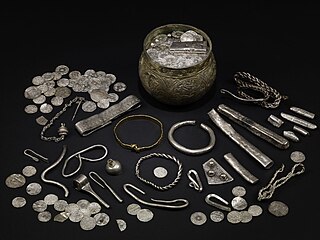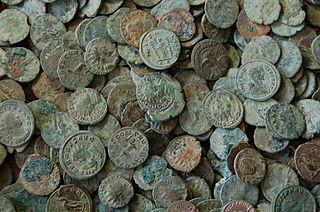
The Ashmolean Museum of Art and Archaeology on Beaumont Street, Oxford, England, is Britain's first public museum. Its first building was erected in 1678–1683 to house the cabinet of curiosities that Elias Ashmole gave to the University of Oxford in 1677. It is also the world's second university museum, after the establishment of the Kunstmuseum Basel in 1661 by the University of Basel.

Taston is a hamlet in Spelsbury civil parish, about 1.6 miles (2.6 km) north of Charlbury and 4 miles (6.4 km) southeast of Chipping Norton, Oxfordshire.

Ceolwulf II was the last king of independent Mercia. He succeeded Burgred of Mercia who was deposed by the Vikings in 874. His reign is generally dated 874 to 879 based on a Mercian regnal list which gives him a reign of five years. However, D. P. Kirby argues that he probably reigned into the early 880s. By 883, he was replaced by Æthelred, Lord of the Mercians, who became ruler of Mercia with the support of Alfred the Great, king of Wessex.

The Alfred Jewel is a piece of Anglo-Saxon goldsmithing work made of enamel and quartz enclosed in gold. It was discovered in 1693, in North Petherton, Somerset, England and is now one of the most popular exhibits at the Ashmolean Museum in Oxford. It has been dated to the late 9th century, in the reign of Alfred the Great, and is inscribed "AELFRED MEC HEHT GEWYRCAN", meaning "Alfred ordered me made". The jewel was once attached to a rod, probably of wood, at its base. After decades of scholarly discussion, it is now "generally accepted" that the jewel's function was to be the handle for a pointer stick for following words when reading a book. It is an exceptional and unusual example of Anglo-Saxon jewellery.

Not to be confused with the Nearby Similarly named Wallingford

The Cuerdale Hoard is a hoard of more than 8,600 items, including silver coins, English and Carolingian jewellery, hacksilver and ingots. It was discovered on 15 May 1840 on the southern bank of a bend of the River Ribble, in an area called Cuerdale near Preston, Lancashire, England. The Cuerdale Hoard is one of the largest Viking silver hoards ever found, four times larger than its nearest rival in Britain or Ireland, according to Richard Hall. In weight and number of pieces, it is second only to the Spillings Hoard found on Gotland, Sweden.

Appleford-on-Thames is a village and civil parish on the south bank of the River Thames about 2 miles (3 km) north of Didcot, in the Vale of White Horse district, in Oxfordshire. It was part of Berkshire until the 1974 local government boundary changes. The 2011 Census recorded the parish's population as 350. On 1 April 2000 the civil parish was renamed from "Appleford" to "Appleford on Thames".

Asthall or Asthal is a village and civil parish on the River Windrush in the West Oxfordshire district, in Oxfordshire, about 6 miles (10 km) west of Witney. It includes the hamlets of Asthall Leigh, Field Assarts, Stonelands, Worsham and part of Fordwells. The 2011 Census recorded the parish's population as 252. Asthall village is just south of the River Windrush, which also forms the south-eastern part of its boundary. The remainder of the parish including all of its hamlets lie north of the river. A minor road through Fordwells forms most of the parish's northern boundary. Most of the remainder of the parish's boundary is formed by field boundaries.

Aston Rowant is a village, civil parish and former manor about 4+1⁄2 miles (7 km) south of Thame in South Oxfordshire, England. The parish includes the villages of Aston Rowant and Kingston Blount, and adjoins Buckinghamshire to the southeast. The 2011 Census recorded the parish's population as 793. The Lower Icknield Way passes through the parish southeast of the village.

The history of the English penny can be traced back to the Anglo-Saxon kingdoms of the 7th century: to the small, thick silver coins known to contemporaries as pæningas or denarii, though now often referred to as sceattas by numismatists. Broader, thinner pennies inscribed with the name of the king were introduced to Southern England in the middle of the 8th century. Coins of this format remained the foundation of the English currency until the 14th century.

The Vale of York Hoard, also known as the Harrogate Hoard and the Vale of York Viking Hoard, is a 10th-century Viking hoard of 617 silver coins and 65 other items. It was found undisturbed in 2007 near the town of Harrogate in North Yorkshire, England. The hoard was the largest Viking one discovered in Britain since 1840, when the Cuerdale hoard was found in Lancashire, though the Anglo-Saxon Staffordshire Hoard, found in 2009, is larger.

The Staffordshire Hoard is the largest hoard of Anglo-Saxon gold and silver metalwork yet found. It consists of almost 4,600 items and metal fragments, amounting to a total of 5.1 kg (11 lb) of gold, 1.4 kg (3 lb) of silver and some 3,500 pieces of garnet cloisonné jewellery. It is described by the historian Cat Jarman as "possibly the finest collection of early medieval artefacts ever discovered".

The Frome Hoard is a hoard of 52,503 Roman coins found in April 2010 by metal detectorist Dave Crisp near Frome in Somerset, England. The coins were contained in a ceramic pot 45 cm (18 in) in diameter, and date from AD 253 to 305. Most of the coins are made from debased silver or bronze. The hoard is one of the largest ever found in Britain, and is also important as it contains the largest group ever found of coins issued during the reign of Carausius, who ruled Britain independently from 286 to 293 and was the first Roman Emperor to strike coins in Britain. The Museum of Somerset in Taunton, using a grant from the National Heritage Memorial Fund (NHMF), acquired the hoard in 2011 for a value of £320,250.

The Silverdale Hoard is a collection of over 200 pieces of silver jewellery and coins discovered near Silverdale, Lancashire, England, in September 2011. The items were deposited together in and under a lead container buried about 16 inches (41 cm) underground which was found in a field by a metal detectorist. It is believed to date to around AD 900, a time of intense conflict between the Anglo-Saxons and the Danish settlers of northern England. The hoard is one of the largest Viking hoards ever discovered in the UK. It has been purchased by Lancashire Museums Service and has been displayed at Lancaster City Museum and the Museum of Lancashire in Preston. It is particularly significant for its inclusion of a coin stamped with the name of a previously unknown Viking ruler.

Viking coinage was used during the Viking Age of northern Europe. Prior to the usage and minting of coins, the Viking economy was predominantly a bullion economy, where the weight and size of a particular metal is used as a method of evaluating value, as opposed to the value being determined by the specific type of coin. By the ninth century, the Viking raids brought them into contact with cultures well familiarised with the use of coins in economies of Europe, hence influencing the Vikings own production of coins.
The Lenborough Hoard is a hoard of more than 5,000 late Anglo-Saxon silver coins, dating to the eleventh century, that was found at Lenborough in Buckinghamshire, England in 2014. It is believed to be one of the largest hoards of Anglo-Saxon coins ever found in Britain. It is now on display at Discover Bucks Museum in Aylesbury.
This page lists major archaeological events of 2015.
Airdeconut was a Norse King of Northumbria. Numismatic evidence suggests he was a Christian and he probably ruled in Northern England around the year 900.

The Piddletrenthide Hoard is a Roman coin hoard dating from the 3rd century AD, found near Piddletrenthide, Dorset. It consisted of 2,114 base silver radiates found in a pottery vessel. The coins date to between 253 and 296 AD.
















